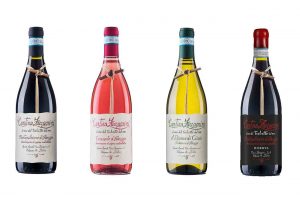It can safely be said that not many wineries boast a visionary cellar housing over 40 works of art spread throughout the cellar and vineyards. Even fewer have shared the early stages of their career in the world of wine with an artist of the calibre of Joseph Beuys, starting with an event dedicated to the ‘Defence of Nature’. And as for those who also tie vine stems around the necks of their bottles to symbolize their close connection with the territory and its traditions, frankly, we’re down to a shortlist of one: Zaccagnini, today proudly part of the Argea Group.

Zaccagnini winery in Abruzzo, Italy
An ever-growing reputation
The winery was set up in 1978 in Abruzzo. Initially, all bottles were sold locally, but as Zaccagnini’s reputation grew, so did its reach. Big investments in technology took place in the 1990s, and at the turn of the millennium the winery’s influence began to spread abroad, particularly in the US. A new winery in 2004 heralded real international expansion, and Zaccagnini is now one of the most important producers in Abruzzo – a real ambassador for this vibrant region.

The distinctive landscape of Abruzzo
Abruzzo is located in central Italy, more or less level with Rome, but across the other side of the Apennine Hills. Vineyards stretch from the latter’s 2000m-high peaks down to the sun-drenched shores of the Adriatic Sea. Zaccagnini is based in Bolognano on the western side of the region, on the mountains’ lower slopes. A beautiful, unspoiled landscape of folded hills, forests and ancient settlements, this part of Italy has come to be known as the ‘green lung of Europe’.

Showcasing the native varieties of Abruzzo
Pride in the region is understandable – and showcasing Abruzzo’s native varieties has always been at the heart of the Zaccagnini philosophy. It’s perhaps at its most obvious in the Tralcetto wines – a range which is premium but accessibly priced, and features classic indigenous varieties such as Pecorino and Trebbiano – as well as Montepulciano (which the winery has been instrumental in championing and uses to make joyful rosé, Cerasuolo d’Abruzzo).
The region’s star rosso is the Montepulciano d’Abruzzo, which is one of the most famous wines of the Tralcetto line. In April a new Tralcetto label was launched: the Tralcetto Montepulciano d’Abruzzo DOC Riserva. This wine offers up a red-fruited expression of the clay soils on which the vines are grown, together with elegant spiced white pepper nuances – the perfect partner for meat based dishes and charcuterie boards.
Tralcetto wines are a pure expression of how the sun, air and slopes interact with the native grapes. The connection between land and bottle is enhanced by the vine sprig hung around the neck of every bottle; a gesture of love for the land that recalls its artisanal past.
The expression of what Abruzzo is capable of reaches its pinnacle in Zaccagnini’s two San Clemente wines, from its top-end ‘cru’ range. The Trebbiano, from old vines, spends 14 days on skins, then six months in untoasted oak, to create a deep golden wine of texture and complexity. With nine months in barrel, and extended bottle-ageing, the Montepulciano d’Abruzzo is rich and complex and can age for 8-10 years. These are fine wines in their own right. But they are also proof of an abiding passion for culture, roots and authenticity; a love story written in wine by one company to the traditions of a region and its people.
Discover more about Cantina Zaccagnini
Connect on
Facebook | Instagram | Twitter | YouTube








